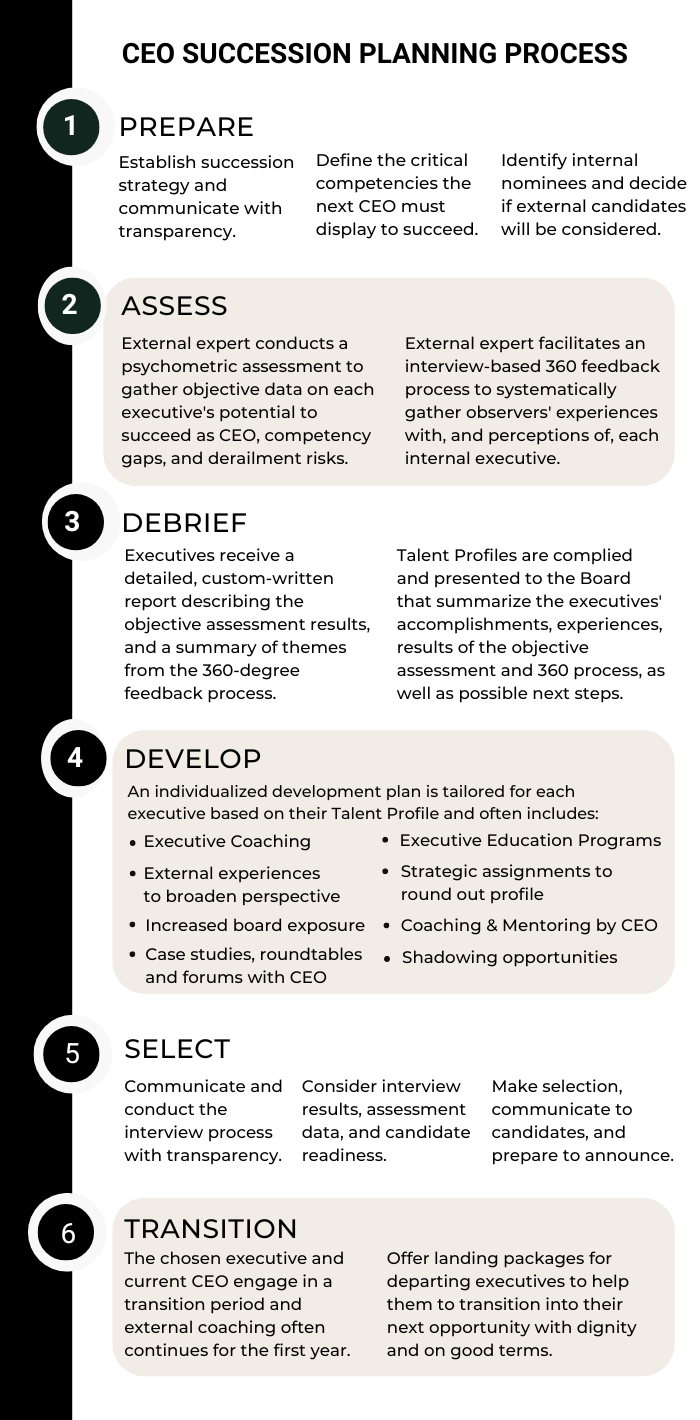CEO Succession Planning
The New Rules of CEO Succession Planning
In a recent article in the pwc publication strategy+business, the authors defined new rules for CEO succession planning. While there are lots of gems in this article, one of the best is: “Start with the what and not the who.”
This means that one of the first things you need to do is define Success Factors. As experts in competency modeling, we gain an understanding of your business strategy, which parts of the culture you want to maintain, and how you need to evolve for the future. We translate that information into Success Factors (i.e., competencies) that are distinct, clearly defined, and measurable. In this way, we provide the Board with a shared understanding of the “what” that will help them to select the right “who.”
We then use those competencies as building blocks for assessing CEO successor candidates, customizing the assessment to measure the competencies and tailoring the deliverables to report on them. This gives the Board a clear understanding of each candidate’s competency strengths and gaps, as well as how/if they can address those gaps.
The article laid out 3 New Rules:
- Start with discussing strategy and where the organization is headed.
- Build a shared framework for assessing and discussing candidates that filters out the noise.
- Structure the process to mitigate bias.
We follow the first two rules when defining Success Factors. We follow the third rule with a structured, 6-step approach that ensures transparency and fairness throughout the process.
6-Step Approach to CEO Succession Planning
We certainly understand why most organizations don’t get excited about CEO Succession Planning. Let’s face it – it can be complicated and messy, and often, internal teams lack the expertise and capacity to do it all themselves. Frequently, the most daunting part is defining the process to identify and groom potential successors. Getting this part right is critical because you’ll rely on this data to short-list potential successors and guide development plans to prepare them to be the next CEO. If you’re looking for a partner to get this right, we’re here to help.
Our 6-step process is outlined below.

The Role of Assessment & Development in CEO Succession Planning
Executive Assessment
Different firms use different methods for conducting CEO succession assessments. Ours is grounded in science and objectivity. This helps you filter out the noise and ensure an unbiased process.
360 Degree Feedback
We usually conduct interview-based 360 for CEO succession because it provides the richest data. We can also create an online tool that measures your success factors.
Development
Because each executive has a unique set of strengths, gaps, risks, and experiences, one size doesn’t fit all. We individualize our approach, so you’ll know where to invest your resources.
Organizations’ biggest mistake in CEO succession planning is not planning at all. Harvard Law School Forum
The Top 3 reasons why organizations don't engage in CEO Succession Planning:
- Having a high-performing current CEO. The Board has a false sense of security and focuses on other priorities.
- Having a hand-picked internal successor in mind. The Board focuses on a person rather than the process. So, if that person leaves and the current CEO steps down, no one else will be ready to fill their shoes.
- Not having a suitable internal candidate in mind. Here again, the Board focuses on a single person—one who may not even exist! Or perhaps they do, but the Board doesn’t see it.
